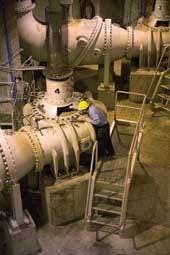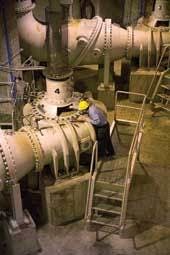by Alan Evans
Pumps constitute one of the largest costs for any municipality. Poor reliability and energy consumption are the major drivers of high costs for most municipalities. Studies have shown that approximately 70% of all pump failures are attributed to excessive leakage from the pump’s sealing system. This includes failures of submersible pumps as well. It has also been reported that approximately 20% to 30% of all electrical energy generated each day is used in the movement of water and other fluids globally. Studies of this energy usage have found that 20% to 50% of this energy is being wasted for a variety of reasons.
There is significant opportunity for a municipality to reduce the costs associated with its pumping systems by taking a comprehensive “Total System” approach to pump operation and maintenance. The total system approach is based on taking a life cycle cost mentality and focusing on the pumping system as an asset that should be managed and not just “lived with.”
The total system approach is focused on the six areas of a pump that contribute to its reliability and energy efficiency. Following is a brief description of each of these areas and steps that can be taken to make a positive impact that will result in improving reliability and lowering overall life cycle costs.
Pump and System Interaction
The first area is to determine where the pump is operating relative to its Best Efficiency Point (BEP). Several studies have documented the impact of “off BEP” operation on a pump’s reliability and energy usage. The fist step is to determine the pump’s typical flow rate as a percentage of the pump’s BEP flow. If the pump is found to be operating in a region that is negatively impacting either its reliability or energy consumption, corrective action should be taken.
There are several options to consider depending on the actual operating point as well as overall reliability/energy impact. Trimming the pump’s impeller is one simple corrective action if the pump is oversized for the application. Another option is to consider the use of a variable speed drive, which will help the pump operate in a better operating regime as flows change throughout the day. In some cases, it may be appropriate and justified to change either the electric motor driving the pump or replace the pump with one better suited for the present and anticipated future flow conditions.
Pump Wet-End
The second area of consideration is the upgrade of the pump’s wet-end to improve hydraulic performance, reliability and energy efficiency. Many pump OEMs (original equipment manufacturers) are offering this service. However, while the modification of the pump impeller can result in slight improvements, this process does not address the real root causes of pump wet-end degradation.
All centrifugal pumps when placed in-service begin a slow process of wear and/or build-up, which significantly impacts the flow efficiency and capabilities of the pump.
Studies have shown and many pump users have verified that the use of Advanced Reinforced Composite Coatings can significantly improve and optimize the long-term performance, reliability and energy efficiency of the pump’s wet-end components. This is one of the greatest areas for improvement in Life Cycle Cost for many centrifugal pumps used in the water and wastewater industry.
Sealing System
Every pump used in the industry requires a sealing device of some type. This is the system that keeps the pumped fluid in the pump and out of the environment. Even submersible pumps use a sealing device to keep the pumpage out of the enclosed electric motor.
Studies have shown that approximately 70% of all pump failures can be attributed to a failure within the sealing system. Therefore, a significant opportunity exists for utilities to improve overall pump reliability by focusing on this critical area.
First, it must be recognized that the sealing device is not a commodity item bought purely on price with no consideration for the application requirements. Although this may show immediate reductions in acquisition cost, the real cost of premature sealing device and subsequent pump failure is neglected. The question should be asked: “What are the real costs attributed to this failure?” The answer will be amazing when all costs are considered.
Second, but just as important, is to stop looking at just the sealing device, whether it is a mechanical seal or compression packing, and start considering the “Sealing System.” A sealing system is more than the sealing device chosen for the application; it also includes the environmental management or control scheme used to provide the sealing device and the three critical elements required for reliable operation. These elements include:
- Lubrication of the primary sealing interface.
- Cooling to remove the heat generated by friction.
- Particles or solids exclusion to keep foreign materials from impacting and contaminating the sealing device.
Typically, a plant will use an external source of fluid or attempt to use the pumped fluid itself to provide these elements for the sealing device. In either case, the question should be asked: “Does the fluid provide these three elements?” Technologies exist that can help to significantly improve the sealing environment to substantially improve reliability.
Bearing System
The fourth area of focus is the pump’s bearing system. Bearing failure is the second leading cause of pump failure and again, bearing systems are one of the most neglected areas of the pump. Like sealing devices, bearings must be lubricated with a clean, cool lubricant in order to operate reliably.
Many bearing failures are the result of contamination that enters the system through the bearing seals supplied with most pumps. Today, technologies exist that can provide significant improvements in sealing the bearings to keep them clean and provide long life.
Lubricant technology continues to evolve, with significant improvements being made that positively impact bearing life and reliability. Consideration should be given to understanding these improvements and determining which is the most suitable for the specific environment and set of conditions the pump will face in-service.
Foundation, Support
The fifth area of consideration is the pump’s base, foundation and support structures. Many good pumps are supported by a very poor base and foundation system, which literally leaves the pump hanging off the piping.
A solid foundation should be of sufficient mass to dampen vibration and provide a solid base to which the pump is mounted. Typically, the pump’s foundation should be three to five times the mass of the pump to provide this level of support.
The base must also be securely attached to the foundation and must be flat, with all mounting surfaces within the same plane so as not to induce any misalignment.
Also, pipe strain must be reduced as this can significantly bend and misalign the pump. A simple test to determine whether this condition exists is to unbolt the piping from the installed pump; if the pipe flanges move away from the pump, there is a potential problem that should be corrected.
The Human Element
The final area of consideration is really the most important. The plant personnel that are responsible for operations and maintenance of the pumps will make the biggest impact on reliability and life cycle cost.
It is a well known fact that failure often can be attributed to an inappropriate human interaction with the machine. However, most times the plant personnel responsible for this interaction really have no idea that they caused a problem.
One of the biggest opportunities for a municipality to make substantial and long-term improvements in pump performance is to invest the time and money to properly train not only the plant operators but also the maintenance staff, engineering and management. This is a small investment that will pay large dividends.
Author:
Alan Evans is the Business Development Manager for the Global Utilities Industry for the A.W. Chesterton Company. Questions and comments can be sent to him via e-mail at [email protected]




